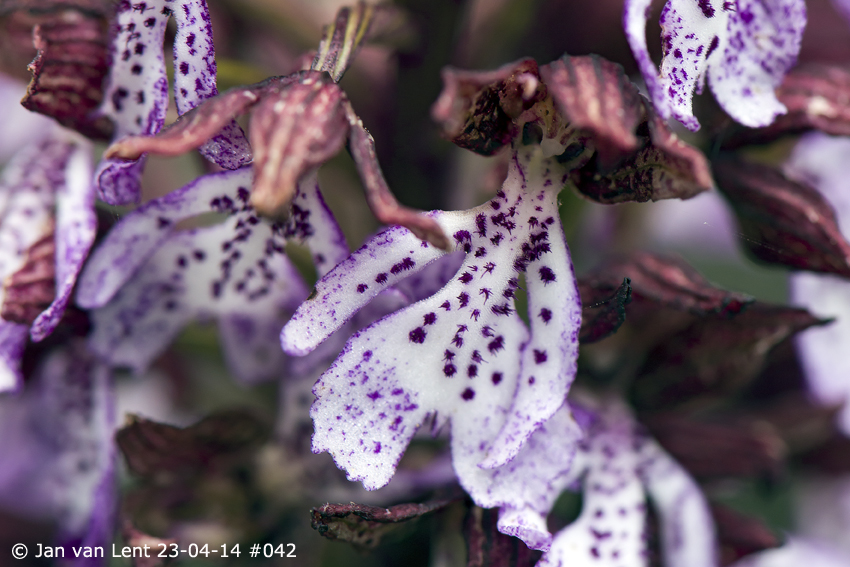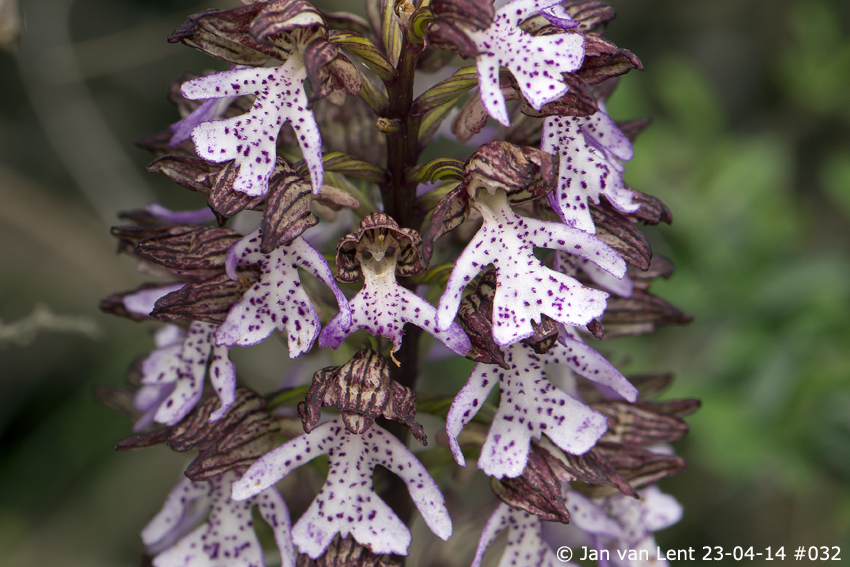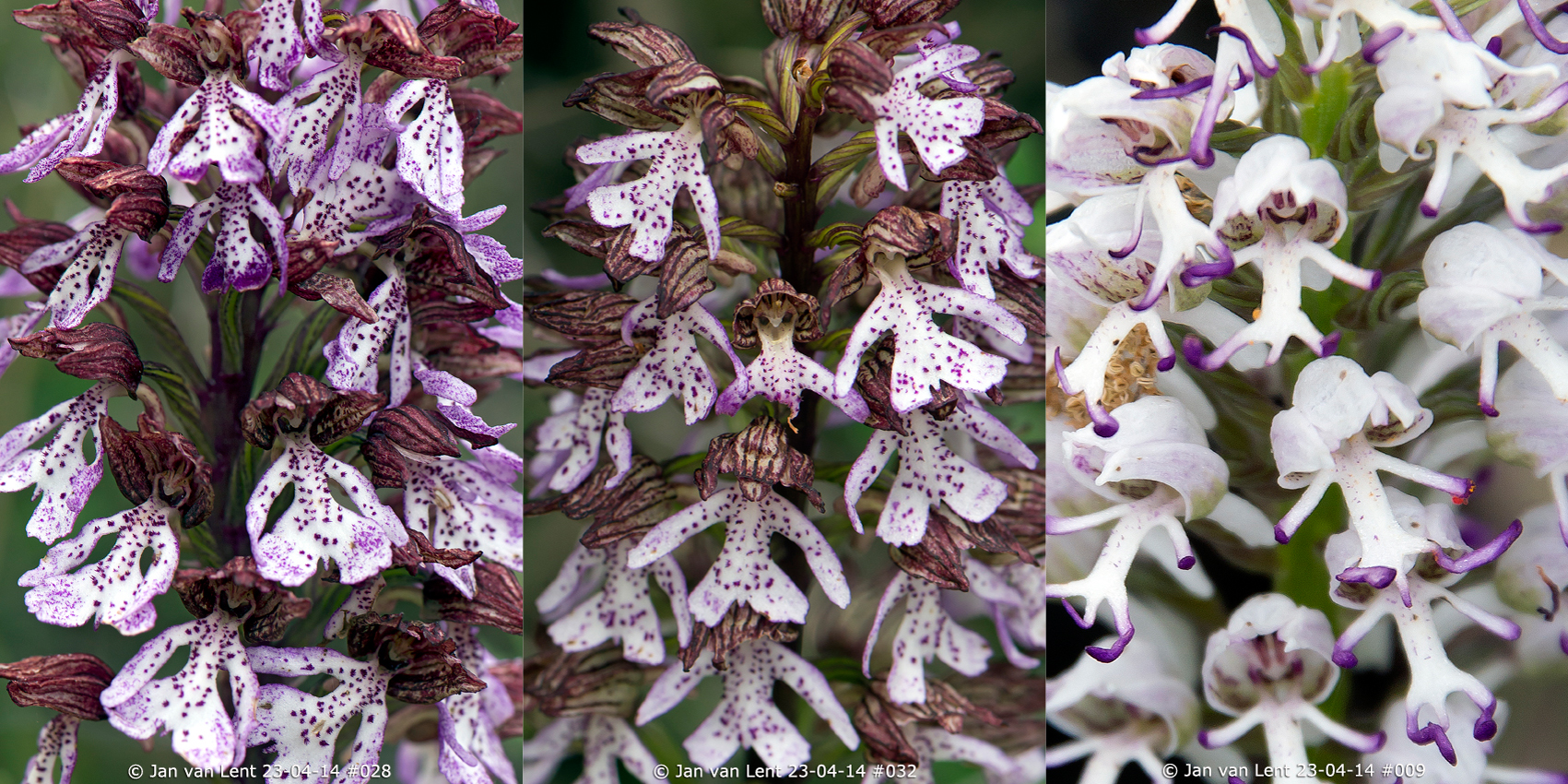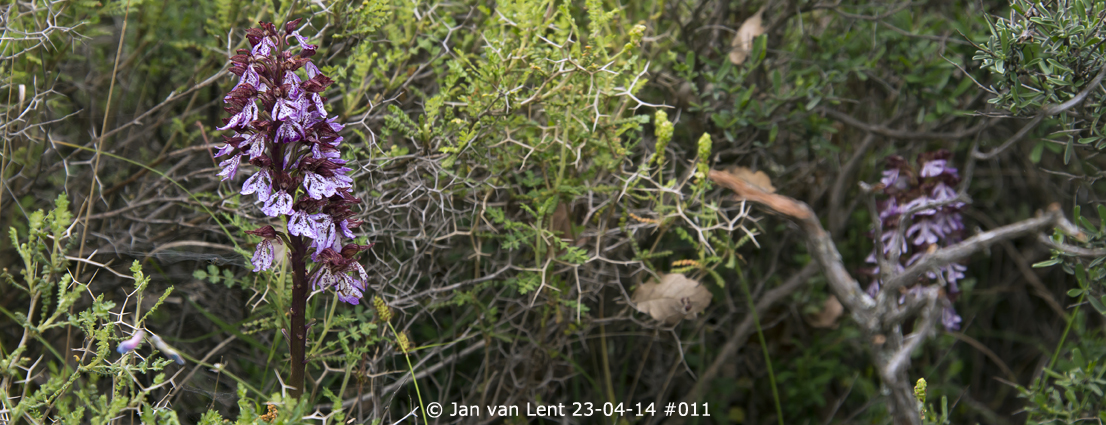Habitat: Mt.Fouga, Pedino, 255 meters above sea level. 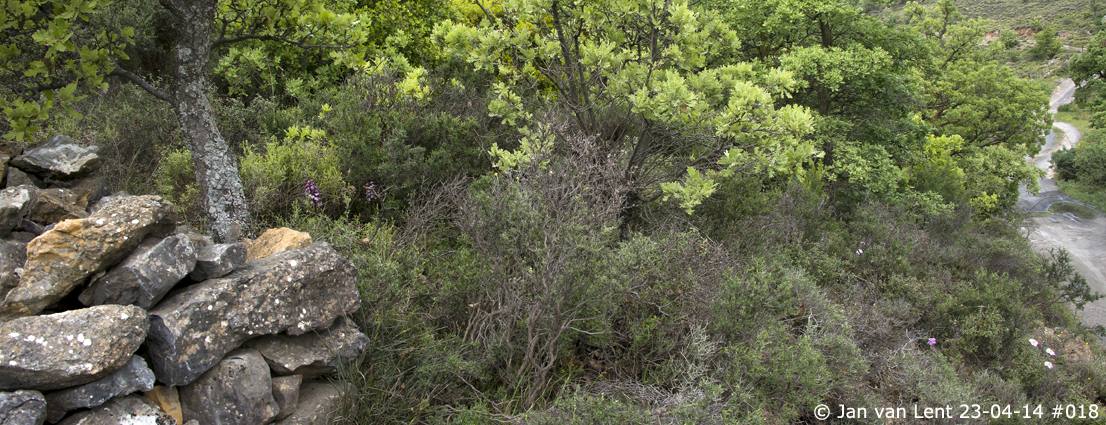
Orchis purpurea, Mt.Fouga, © Jan van Lent 23-04-14 #018.
Orchis purpurea HUDSON 1762.
Orchis purpurea subsp. purpurea KRETZSCHMAR ET AL., 2007.
HUNTING: Well, hunting is not the correct word in this case, finding is already a bit more accurate, and detecting is maybe the word I’m looking for. For years I (and other orchidologists) was hunting for this purple Lady Orchid* in the south of the island, around Megalochori, because BIEL (1998) and KARATZÁ (2007) indicated that they found this Lady Orchid there. And at least BIEL wrote that he saw it only once and also for the last time in flower, almost 20 years ago, in April 1995. But here it is in 2014, in the ultimate north of the island, and it was Dutch ecologist Alex Tabak (www.crossbillguides.com) and Christiana Bairaktari (www.hellenicwholefoods.com) who recovered this big, remarkable orchid again on a track on their way to Liota/Ligeri and gave me the directions to find them.
Orchis purpurea, Mt.Fouga, © Jan van Lent 23-04-14 #042
HABITAT: This Purple orchid travelled a long way in the last 20 years, maybe hitchhiking in the hairs of wild goats, on the back of a tortoise or maybe through air as seeds with birds? The distance between Megalochori and Mt. Fouga is about 80 km as the crow flies, but by road it will take you in a car almost half a day. So how did it come here? Was it maybe always growing here? I asked a local inhabitant if she knew about wild orchids but she pointed out that she only saw orchids in her garden. So this question will maybe remain unanswered for ever.
Orchis purpurea, Mt. Fouga, © Jan van Lent 23-04-14 #032
The oak forests in the north and west of Lesvos are the old original vegetation of the island but disappeared almost completely because of the need of wood for building boats and firing the stove, edible vegetations for sheep, olive groves and nowadays vineyards. In some inhospitable places it comes back discreetly and when the undergrowth is not intensively eaten by goats and sheep it can be a new habitat for orchids like Orchis purpurea and Orchis simia, – the latter is flowering here in abundance. I found also a few members of the Ophrys oestrifera-family: a lot of Anacamptis pyramidalis and even Cephalanthera longifolia and Limodorum abortivum were thriving in those woods. The other (almost impenetrable) vegetation consisted almost totally out of Shaggy Cistus, Thyme, Prickly Asparagus and Thorny Burnet. And because the head of Orpheus was buried in a cave nearby the nightingales sing also more sweetly on this mountain than anywhere else…
2 Orchis purpurea & 1 Orchis simia, Mt. Fouga, © Jan van Lent 23-04-14
RESEARCH: Until recently I should be quickly done with my research on the Purple (Lady) Orchid, because ‘everybody’ agreed on its morphological appearance, the name, date and author of Orchis purpurea Hudson 1762. But ‘things’ are changing fast in orchid ‘circles’: BATEMAN, PRIDGEON & CHASE and KRETZSCHMAR ET AL. reshuffled a lot of species in the genera Aceras, Anacamptis, Neotinea and Orchis (see also blog 19, 20) in recent years. For almost 250 years (between 1762 and 2006) its name didn’t change until KRETZSCHMAR and BAUMANN made the name a bit longer: so now it is Orchis purpurea subsp. purpurea KRETZSCHMAR ET AL., 2007 because BAUMANN ET AL are the authors of Orchis purpurea subsp. caucasica (Regel) B. BAUMANN & AL, and Orchis purpurea subsp. lokiana (B and/or H. BAUMANN) H. BAUMANN & R. LORENZ so there had to be an Orchis purpurea subsp. purpurea first.
Relief in orchid land! So we don’t have to change the genus of this Orchis nor do we actually have to change the author’s name because KRETZSCHMAR wasn’t the author of this orchid, he only changed its name. Now we are all waiting for an orchidologist who will try to change this to Orchis purpurea var. purpurea… or worse: ‘my’ second more brownish Orchis purpurea to Vermeulia purpurea var. sappho.
Orchis purpurea,Mt.Fouga, © Jan van Lent 23-04-14 #011.
BOTTOM-LINE: Choosing the Catholic Pope is a very difficult matter. They lock up the Cardinals (sometimes for weeks) in a room with a fire place and when they have decided who should be the new Pope, they produce white smoke and everybody can come out of the room and live happily ever after. Choosing genera & species names for orchids is also a difficult matter. I heard orchidologist (Carsten Schmegel) propose that we should lock up Bateman et al., Kretzschmar et al, Baumann et al., Paulus et al, Tyteca & Klein, C.A.J. Kreutz, Pedersen and Faurholdt, Delforge and the whole Devillers-gang in a room and they only can come out if we see white smoke coming out of the chimney, when they have finally decided about which orchids belongs to which genera, about decent species names and a unified species theory for orchids that will last 10-20 years or so. With great pleasure I agree with him.
Jan van Lent, Lesvos 26-4-2014.
Purple Haze: Jimi Hendrix Experience.
https://www.youtube.com/watch?v=VFHPgoZlSWY
*There exists also a Dancing Lady Orchid (Oncidium altissimum) but that grows in Jamaica (so why not Reggae Lady Orchid?) and a Pink Lady’s Slipper orchid (Cypripedium acaule), A Queen Lady’s Slipper Orchid (Cypripedium reginae) and, and… But those are not Wild European Orchids but Tropical or Asian Orchids (Yes, those that you buy in flower shops and supermarkets).

